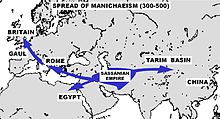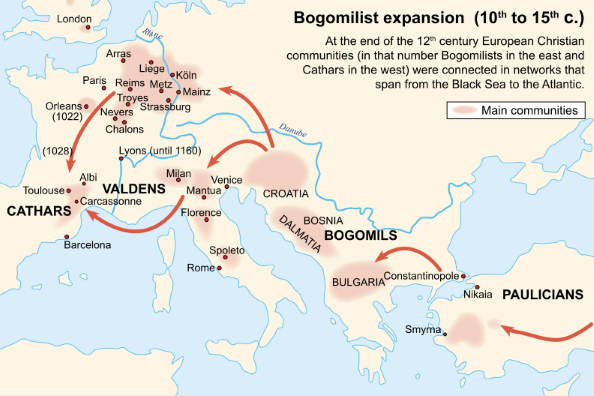Christian franchises
In the limited education we get on the history of religion, most of us acquire a kind of binary (or black and white) view of how Christianity separated from Judaism. It's a very simplistic notion along the lines of Christians aren't Jews, and visa versa. In Britain, many of us have only a hazy idea of how Christianity got established. For example:
Augustine, the first Archbishop of Canterbury, arrived on the coast of Kent as a missionary to England in 597 AD. He came from Rome, sent by Pope Gregory the Great. It is said that Gregory had been struck by the beauty of Angle slaves he saw for sale in the city market and despatched Augustine and some monks to convert them to Christianity. Augustine was given a church at Canterbury (St Martin’s, after St Martin of Tours, still standing today) by the local King, Ethelbert whose Queen, Bertha, a French Princess, was already a Christian. This building had been a place of worship during the Roman occupation of Britain and is the oldest church in England still in use.
Ref : Canterbury
Interesting that the “building had been a place of worship during the Roman occupation of Britain”, although it would be good to know what kind of worship they mean. Perhaps Mithraic?
But Augustine wasn't the first Christian Bishop in Britain, he was the first Roman Catholic Christian Bishop. There were well-known Christians that pre-date him. For example, Pelagius, born c.354AD, was a British-born ascetic moralist, who became well known throughout ancient Rome.
Where did these other Christians come from?
To answer that question, we have first to understand and recognise that there were several competing groups, all with Judeao-Christian roots. These all produced theologies that differed from the Roman model that blinkers our perception of what a Christian is.
Mandaean Baptists
A large group of followers of John the Baptist, they decided they didn’t like being ruled by Rome or by Judea, and upped-sticks and moved to “Mesopotamia”.
the quasi-historical Mandaean document, the Haran Gawaita, which narrates the exodus from Palestine to Mesopotamia in the 1st century AD of a group called Nasoreans (the Mandaean priestly caste as opposed to Mandaiia, the laity).
Ref : Mandaeanism
Actually to a region called Media, which was:
a region of north-western Iran, best known for having been the political and cultural base of the Medes. During the Achaemenid period, it comprised present-day Iranian Azerbaijan, Iranian Kurdistan and western Tabaristan.
Ref : Media
Stray thoughts ... why did the Mandaean Nasoreans (followers of John The Baptist) choose to go all the way from Judea to Media (Azerbaijan/Kurdistan)? Perhaps that’s where the Zoroastrian Magi (Three Wise Men) came from, to check-up on the prophet that came after John The Baptist?
The Babylonian Elchasaites
Babylonian Elchasaites rejected Pauline Christianity, and were one of the first Gnostic Christian movements, with connections to Cathars and Bogomils.
Manichaeism
The term "Manichean" is widely applied (often used as a derogatory term) as an adjective to a philosophy of moral dualism, according to which a moral course of action involves a clear (or simplistic) choice between good and evil, or as a noun to people who hold such a view.See Pelagius.
During the third century, Mani founded a Dualist-Gnostic religion that drew on Christianity as well as Zoroastrianism and Buddhism, and his Manichaean faith endured through the end of the Middle Ages. ... Mani’s mother was Parthian, but his father, Patik, belonged to a very significant group called the Elchasaites. This name takes us back to very early forms of Jewish-Christian belief. ... This baptist sect was related to the Jewish-Christian Ebionites, and also, possibly, to the Jewish Essenes. ... The fourth century writer Epiphanius of Salamis discusses Elchasai in the context of a group of Jewish and Jewish-Christian sects, including Nazareans, Ossaeans (?Essenes) and Sampsaeans.
Ref : Mani
This is not an extinct religious group; it still exists in small communities in "Persia", Iraq and Iran.
Manichaeism spread with extraordinary speed through both the east and west. It reached Rome through the apostle Psattiq by a.d. 280, who was also in Egypt in 244 and 251. It was flourishing in the Fayum area of Egypt in 290. Manichaean monasteries existed in Rome in 312 during the time of the Christian Pope Miltiades. ... It thrived between the third and seventh centuries, and at its height was one of the most widespread religions in the world. Manichaean churches and scriptures existed as far east as China and as far west as the Roman Empire. It was briefly the main rival to Christianity in the competition to replace classical paganism. ... How Manichaeism may have influenced Christianity continues to be debated. Manichaeism may have influenced the Bogomils, Paulicians, and Cathars. ... The Manichaeans preserved many apocryphal Christian works, such as the Acts of Thomas, that would otherwise have been lost.
Ref : Manichaean

Does it seem odd or unusual that “Manichaeism spread with extraordinary speed through both the east and west”? Ideas can spread like wildfire, given the right conditions, when people feel oppressed, or have feelings of a spiritual drought.
Something very similar seems to have happened when Bogomilism headed west.
Bogomilism
Bogomilism (see Gnosticism) was a Christian neo-Gnostic or dualist religiopolitical sect founded in the First Bulgarian Empire by the priest Bogomil during the reign of Tsar Peter I in the 10th century. It most probably arose in what is today the region of Macedonia as a response to the social stratification that occurred with the introduction of feudalism and as a form of political movement and opposition to the Bulgarian state and the church. .. The Bogomils were dualists or Gnostics in that they believed in a world within the body and a world outside the body. They did not use the Christian cross, nor build churches, as they revered their gifted form and considered their body to be the temple.
Ref : Bogomilism

Shown in the map above as "Valdens", but a.k.a. Waldensians (a proto-Protestant church
Ref : Waldensians
Czech Protestants
We often think of Martin Luther lighting the torch of the Reformation, but the Czechs have the oldest Reformation tradition in mainland Europe. Long before Luther nailed his theses to the door of Wittenberg Church in 1517, the Czechs had established their own national Protestant church with their own vernacular Bible and hymn book. In 1406 or 1407 and perhaps as early as 1385, Czech students studying at Oxford brought back to Prague the writings of John Wyclif. The rector of Charles University in Prague, Jan Hus (1372?-1415), a man of outstanding intellectual gifts and personal integrity, took up Wyclif’s ideas.
Ref : The Rosicrucian Enlightenment Revisited, p. 201
The Significance of the Lollard Bible
Ref : https://medievalchurch.org.uk/pdf/lollard_deanesly.pdf
Prague became a Mecca for those interested in esoteric and scientific studies from all over Europe. Hither came John Dee and Edward Kelly, Giordano Bruno and Johannes Kepler. However strange the reputation of Prague in the time of Rudolph it was yet a relatively tolerant city. Jews might pursue their cabalistic studies undisturbed (Rudolph’s favourite religious adviser was Pistorius, a Cabalist) and the native church of Bohemia was tolerated by an official ‘Letter of Majesty’. The Bohemian church, founded by John Huss, was the first of the reformed churches of Europe. Rudolph’s toleration was extended to the Bohemian church and to the Bohemian Brethren, a mystical brotherhood attached to its teachings. Prague under Rudolph was a Renaissance city, full of Renaissance influences as they had developed in Eastern Europe, a melting pot of ideas, mysteriously exciting in its potentiality for new developments.”
Ref : Francis Yates, The Rosicrucian Enlightenment (p. 26)
Last, but not least, Coptic Christianity
The Egyptian Church, which is more than 1,900 years old, and most likely the oldest Christian church in the world, traditionally believed to be founded by St Mark at around AD 42. ... The Catechetical School of Alexandria is the oldest catechetical school in the world. St. Jerome records that the Christian School of Alexandria was founded by Saint Mark himself ... Many scholars such as Jerome visited the school of Alexandria to exchange ideas and to communicate directly with its scholars. The scope of this school was not limited to theological subjects; science, mathematics and humanities were also taught there. The question-and-answer method of commentary began there ... Christian monasticism was born in Egypt and was instrumental in the formation of the Coptic Orthodox Church character of submission, simplicity and humility
Ref : Coptic Orthodox Church
This is significant; the Coptic Church traditions maintain that:
It is known in the ecclesiastical history of the Church of Alexandria that the Church had sent missionaries in the 3rd or 4th century to the Celtic lands, especially monastics. It is also known within the Celtic tradition, especially in Ireland, that the foundation of the monastic system among the Celts was either based in portion on or inspired by the Egyptian monastic system, and there are many traces of Alexandrine theology embedded in Celtic theology.
